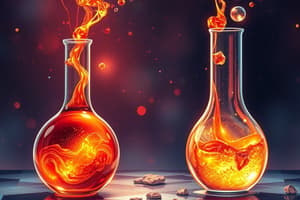Podcast
Questions and Answers
Which property allows solids to maintain a fixed shape and volume?
Which property allows solids to maintain a fixed shape and volume?
- Free movement of molecules
- Close packing of molecules (correct)
- High compressibility
- Vibrational motion of molecules
What characteristic prevents liquids from being compressed easily?
What characteristic prevents liquids from being compressed easily?
- Molecular arrangement (correct)
- High density
- Fixed volume
- Surface tension
Which property of gases describes their ability to spread and mix due to molecular motion?
Which property of gases describes their ability to spread and mix due to molecular motion?
- Incompressibility
- Diffusion (correct)
- Viscosity
- Elasticity
Which of the following best describes the density of solids compared to gases?
Which of the following best describes the density of solids compared to gases?
What is the main reason for the high compressibility of gases?
What is the main reason for the high compressibility of gases?
Which property distinguishes liquids from solids regarding their shape?
Which property distinguishes liquids from solids regarding their shape?
What is a common feature of both solids and liquids regarding their density?
What is a common feature of both solids and liquids regarding their density?
Which property of solids relates to their ability to return to the original shape after deformation?
Which property of solids relates to their ability to return to the original shape after deformation?
Flashcards are hidden until you start studying
Study Notes
Matter
Properties of Solids
- Definite Shape and Volume: Solids maintain their shape and occupy a fixed volume.
- Molecular Arrangement: Molecules are closely packed in an orderly arrangement, vibrating in fixed positions.
- Density: Generally have high density due to closely packed particles.
- Incompressibility: Difficult to compress because particles are already tightly packed.
- Elasticity: Ability to deform and return to original shape when the force is removed (depends on material).
- Thermal Conductivity: Good conductors (metals) or insulators (wood, plastic) based on the molecular structure.
Properties of Liquids
- Definite Volume but Indefinite Shape: Liquids take the shape of their container but maintain a constant volume.
- Molecular Arrangement: Molecules are close together but can move past one another, allowing flow.
- Moderate Density: Less dense than solids but more dense than gases.
- Incompressibility: Generally incompressible, though slightly compressible under extreme pressure.
- Surface Tension: Molecules at the surface experience a net inward force, resulting in a "skin-like" effect.
- Viscosity: Resistance to flow; varies widely among different liquids (e.g., honey vs. water).
Properties of Gases
- Indefinite Shape and Volume: Gases expand to fill the shape and volume of their container.
- Molecular Arrangement: Molecules are far apart and move freely at high speeds.
- Low Density: Much lower density compared to solids and liquids due to large spaces between particles.
- Compressibility: Highly compressible; volume decreases significantly under pressure.
- Diffusion: Gases spread out and mix due to the random motion of molecules.
- Pressure: Gases exert pressure on walls of their container due to molecular collisions.
General Concepts
- Phase Changes: Matter can transition between solid, liquid, and gas states (e.g., melting, freezing, evaporation, condensation).
- Temperature Influence: Temperature affects the energy and movement of particles, influencing the state of matter.
Properties of Solids
- Solids possess a definite shape and volume, maintaining their form without external support.
- Molecules are closely packed in a regular structure, allowing only vibrational movement in fixed positions.
- High density is typical in solids due to the compact arrangement of particles.
- Solids are generally incompressible, as the tightly packed particles do not allow volume reduction.
- Elasticity refers to a solid's ability to revert to its original shape after deformation, influenced by the material's properties.
- Thermal conductivity varies, with metals often acting as good conductors, while materials like wood and plastic serve as insulators.
Properties of Liquids
- Liquids have a definite volume but take the shape of their container, adapting to external forms.
- Molecules are closely packed yet mobile, allowing liquids to flow and change shape easily.
- Liquids demonstrate moderate density, generally falling between the densities of solids and gases.
- While mostly incompressible, liquids can exhibit slight compressibility under extreme pressure.
- Surface tension arises from the cohesive forces between liquid molecules at the surface, creating a "skin-like" effect.
- Viscosity measures a liquid's resistance to flow, which varies significantly (e.g., honey is more viscous than water).
Properties of Gases
- Gases have neither a definite shape nor volume, expanding to fill their container entirely.
- Molecules are widely spaced and free to move at high speeds, leading to minimal attractive forces between them.
- Gases possess low density compared to solids and liquids, primarily due to the significant distances between particles.
- Gases are highly compressible, allowing their volume to decrease substantially under pressure.
- Diffusion occurs as gas molecules randomly move, causing them to disperse and mix throughout the available space.
- Gases exert pressure on the walls of their container as a result of molecular collisions, which is a fundamental characteristic of gaseous behavior.
General Concepts
- Phase changes allow matter to transition between states (solid, liquid, gas), including processes like melting, freezing, evaporation, and condensation.
- Temperature plays a critical role in determining the energy and movement of particles, thus influencing the state of matter and its properties.
Studying That Suits You
Use AI to generate personalized quizzes and flashcards to suit your learning preferences.




